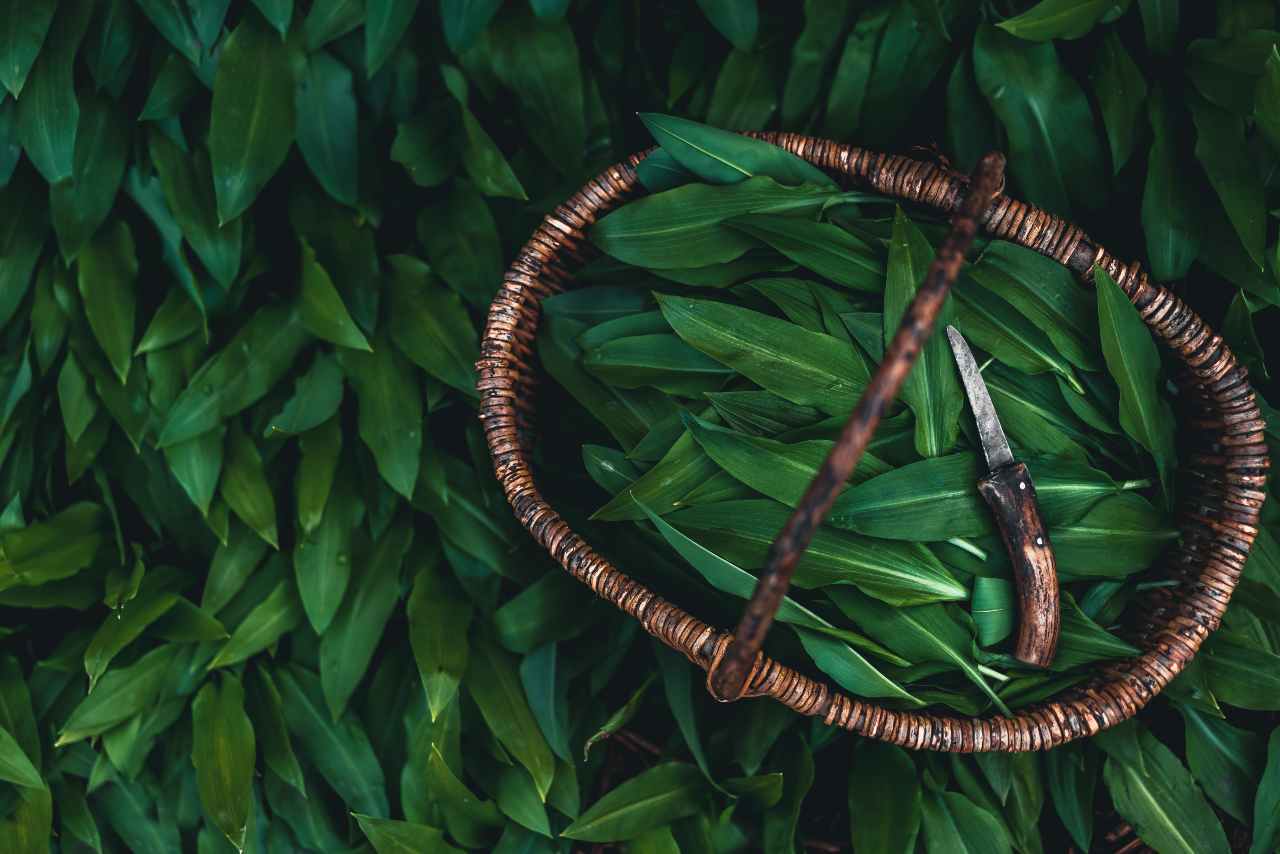Cegin y Werin #4 - Spring Equinox || Dandelion, Wild Garlic & Nettle
You can feel it in the air. You can hear it in the birdsong. And you can notice it in the smiles of the flowering Daffodil, Celandine, Snowdrop, Wood Anemone and Crocus. The awakening of Spring, the dawn of the year.
Have you ever thought about how you recognise the beginning of Spring? Is it the plant life? The weather? How does a plant know when it is time to grow? The Spring Equinox, or to use it’s Welsh/Brythonic name Alban Eilir ‘the light of Spring’ to the Celtic forebears of this land, falls on the 21st or 22nd of March each year, marking the return of life after the winter. But a plant cannot tell the time or see a calendar. Yet it knows. I find that so awesome and wonderful every Spring. The time of the sowing of seeds has come again, the day is as long as the night. This is a tipping point. Spring has well and truly arrived (though some of the icy cold rain we’ve had lately might test that theory!).
On the first sunny days, we work up a sweat, making garden beds with the compost that has been quietly working all winter. We sow the first seeds outside - parsnips, sugar snap peas and broad beans - and fill the propagation house with the promise of beetroot, kale, tomatoes, chillis, peppers, salads and more. Aware that as the weeks tumble by, the momentum of the season will gather pace, and we work hard to try to be as organised as possible for the coming madness! Our volunteers are a great help in that endeavour, and despite the wind and rain, the turnout has been strong and the enthusiasm lively!
In the edges and hedges and the woodland beyond the garden, the lush green leaves of some of the sentinel plants of Spring are lush and full - Dandelion, nettle and in the shade of budding trees, wild garlic carpets the woodland floor.
As we enter what is known to veg growers as the ‘Hungry Gap’, a time when, no matter how skilled or experienced, no matter how good your compost or whether you talk to the plants at night, no matter how good our relationship with the land we work, it becomes very hard to be producing food, wild foods and forage from outside the growing beds becomes so important. Before imported produce was affordable for the masses, eating in the hungry gap was both hard and uninspiring – a diet dominated by old potatoes and cabbage - so wild foods like nettle and seaweed added variety, nutrition & substance to supplement the Hungry Gap diet of peasant folk.
So in this article, we want to introduce three of the common wild plants that we are eating and working with at this time of year.
Danadl | Nettle
The early shoots of nettle are ready to harvest. This common, abundant and underrated edible plant is all around you, but be sure to wear gloves if you don’t want to get stung! Stinging nettle (Urtica dioica) has been a staple in herbal medicine since ancient times, and is an easy way to add some deep nutrition into your dishes without spending a penny!
Nettle use has been recorded as far back as the Bronze Age (3000 BCE – 1200 BCE), and between 58 and 45 BCE, there are records of Nettle’s stinging properties assisting Julius Caesar’s troops in helping them stay awake and alert during the night. It was a common household textile in Scottish households during the 16th and 17th centuries and during the First and Second World Wars, Nettle fibre was used as a substitute for cotton yarns, when this material was unavailable. Because of its strong and sturdy fibers, Nettle would be a great ally if you were ever stranded in a forest, as it can be used to make natural cordage. This natural cordage could then be used to help build a shelter, start a fire, fashion clothing, make tools, and more, making it the ideal plant to have around in a survival situation.
Its scientific name, Urtica dioica, comes from the Latin word uro, which means “to burn,” because its leaves can cause a temporary burning sensation upon contact. You’ve all felt it! Nettle, in teas, or cooked in soups or stir fries can help purge harmful chemicals and excess liquid from the body. Worried about stinging yourself if you eat it? Don’t be afraid, the sting is neutralised as soon as the leaves are steeped in hot water or cooked in any way. It’s vitamin C helps your body to better absorb iron, helping to alleviate anaemia and fatigue. It’s full of vitamin D and balances out the lack of sunlight we might be experiencing after a long winter!
We love to use it in a soup, combining it with potatoes, herbs and spices (and maybe some Wild Garlic) to make a hearty, warming and healing meal. Here’s a wonderful recipe for working with Nettle from Tara Crank, a friend and volunteer at Glasbren, in a video she made for our friends at Coed Lleol.
Garlleg Gwyllt | Wild Garlic | Ramsons
Living in the damp forest hollows near to streams, is Wild Garlic, a favoured food of brown bears and one of the more luxurious offerings of the wild for the keen forager at this time of year. It grows from bulbs in the soil, and the best ay to use it is to harvest the young leaves while they are fresh and full of flavour (only take what you need, please harvest responsibly).
One of our favourite ways to use wild garlic is in a pesto! This recipe is delicious thrown through pasta, swirled through soups and stews or served as a condiment to baked potatoes. Try using it as a salad dressing or popping a few dabs into your favourite sandwich. Your pesto will keep for at least a week in the fridge, or you can store it for longer by sterilising and sealing your jars. You can find out how to do that easily online.
Recipe || Wild Garlic Pesto
A good handful of leaves, 100 ml olive oil or rapeseed oil, 100 g hazelnuts or sunflower seeds, 100g cheese good hard cheddar or parmesan, 1 lemon juice
Pick your wild garlic! Choose your spot carefully away from dog walking spots.
Wash the leaves carefully and finely chop them finely
Grind the nuts or seeds with a pestle and mortar (Remember last week when I talked about the Essentials buying group? They are a great place to source large bags of nuts and seeds). Of course you can use an electronic mixer but it is more fun by hand!
Add the garlic leaves, oil, cheese and lemon juice and mix in pestle and mortar. Mix into a thick paste adding more oil if needed.
Use as a dip or add to a bread dough or dollop onto a soup or .. in any way you want!
Dant y Llew | Dandelion | Dant de Lion
One of our most common ‘weeds’ is also highly edible! Dandelion has followed in the footsteps of pilgrims for millenia. The genus, with over 250 species, grows all over the world. As most of us know, dandelion thrives just about anywhere. What isn’t as well known is that it improves soil quality. Roots draw minerals up from deep layers of earth – concentrating them in the whole plant. When the plant dies back it deposits these minerals into the soil. Roots also aerate hard packed soil and create pathways for water to enter.
Dandelion also contains an impressive list of nutrients. Leaves are high in vitamins and minerals including Potassium, Calcium, Magnesium, Iron, and vitamins A, B and C. Dandelion is higher in Vitamin A than any other garden plant. Roots contain inulin, mucilage, latex resin, and teraxacin.
Eating Dandelion
Leaves – Dandelion leaves can be a gourmet green if you know when to harvest and how to prepare them. Dandelion leaves have three times more Calcium, Iron, and Vitamin A than spinach! Leaves can also be steamed, sautéed or boiled and then incorporated into dips, casseroles and soups. Boiling bitter leaves in a pot of water for about 5 minutes helps to remove some of the bitter taste.
Buds – The key to eating dandelion buds is getting them early when they are still tight little buttons close to the base of the plant. I like them best when the sepals have just unfolded. I pinch off the sepals from the base of the bud because they are a little bitter. Buds can be pickled, added to sautés, soups, etc.
Flowers – What most of us think of as a single dandelion flower is actually hundreds of flowers growing together on a single base. Dandelion flowers are high in Vitamin A and have a surprisingly sweet and mild flavor. The base of the flowering head and especially the green sepals (they look like tiny leaves) are bitter. You can easily pull the flowers off and use them straight or in recipes. I find them a little dry when sprinkled heavily on salads or other raw dishes so I prefer to add them to cooked foods like quiche, pancakes, muffins, and fritters.
RECIPE || Dandelion Sesame Chutney
Ingredients:
1 onion, lemon juice, two cups of dandelion leaf, salt, olive oil, tahini, water, 2 garlic cloves
chop dandelions
peel onion and cut it into 4 pieces
peel garlic
add onion garlic, 1 cup of water, half a cup of tahini, ¼ cup of olive oil, ¼ cup of lemon juice as well as two teaspoons of salt into a blender and mix until smooth
Taste and add more lemon juice if you need to as well as seasoning
Living in tune with the seasons helps bring variety and flow to life. It helps us to observe and celebrate the subtle changes around us, and join in celebrations observed since ancient times. Aligning our diet with the wild plants that are growing at different times through the year, too, can help us to feel closer and more attuned to that turning wheel of the seasons. As gardeners, the Equinox reminds us of the opportunity to start anew, and approach a new season with fresh eyes.
Here’s to an abundant season. Lets hope the weather is smiling on us all!



